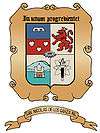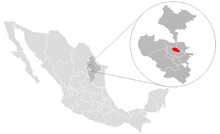San Nicolás de los Garza
San Nicolás de los Garza, sometimes known only as San Nicolás, is a city and coextensive municipality in the Mexican state of Nuevo León that is part of the Monterrey Metropolitan area. It has become primarily a city for residencies and family houses, although it still has several factories that tend to relocate to the periphery of the metropolitan area. It is the third-largest city in the state, behind Monterrey and Guadalupe.
San Nicolás | |
|---|---|
 Coat of arms | |
| Nickname(s): San Nicolás | |
| Motto(s): In Unum Progedientes | |
 Location of San Nicolás de la Garza in northern Mexico | |
| Coordinates: 25°45′N 100°17′W | |
| Country | Mexico |
| State | Nuevo León |
| Founded | 5 February 1597 |
| Government | |
| • Mayor | Pedro Salgado (PAN) |
| Area | |
| • City | 86.8 km2 (33.5 sq mi) |
| Elevation | 512 m (1,680 ft) |
| Population (2005) | |
| • City | 476,761 |
| • Density | 5,493/km2 (14,230/sq mi) |
| • Metro | 3,664,331 |
| Time zone | UTC-6 (Central Standard Time) |
| • Summer (DST) | UTC-5 (Central Daylight Time) |
| Website | www |
It houses the Universidad Autónoma de Nuevo León (Autonomous University of Nuevo León), one of the most prestigious public schools in Mexico and Latin America.
San Nicolás, although less populated than Monterrey, has the higher population density.
History
San Nicolás de los Garza was founded on 5 February 1597 and given the name of Estancia de Pedro de la Garza (Pedro de la Garza’s Estate), then Estancia de San Nicolás (Saint Nicholas’ Estate), and finally Estancia de San Nicolás de los Garza (Saint Nicholas of the Garzas’ Estate). The first people that inhabited the terrain were Amerindian, mostly nomads. They were the Alazapas, the Ayalas and the Alincheños.
San Nicolás was founded right after Monterrey, when Diego de Montemayor granted permission to inhabit the area to his secretary, Diego Díaz de Berlanga; Pedro de Iñigo; Domingo Manuel; and D. Pedro de la Garza. The members of these families are considered the first settlers of the city.
Diego Díaz de Berlanga was the person that redacted Monterrey's Foundation Act, and authorized the first land permissions to its first settlers.
In 1830 the area was declared to the category of village, with the name of San Nicolás de los Garza, in honor of the patron saint of the town. On 12 May 1970 it was declared a city.
Government
San Nicolás de los Garza is a municipality governed by a democratically elected Presidente Municipal (Municipal President or Mayor) for a period of 3 years with no right to reelection. The political environment is one of civility. Since the decade of the 80's, the PAN has remained in office.
The City Council of San Nicolás de los Garza (Cabildo de San Nicolás de los Garza) is an organ integrated by the Mayor, the Regidores and the Síndicos. The Mayor is the executor of the determinations of the City Council and the person directly in charge of the public municipal administration. The Regidores represent the community and their mission is to collectively define the city policies in all the subjects affecting it. The Síndicos are in charge of watching and legally defend the city interests, as well as in charge of watching the City Treasury status and the municipal patrimony.
The current Mayor of San Nicolás is Pedro Salgado Almaguer (PAN), who was elected in the past municipal election and will remain in office until 2016.
The political parties with representation in the city are the Institutional Revolutionary Party or PRI, the National Action Party or PAN, the Party of the Democratic Revolution or PRD, the Labor Party or PT, the Green Party, Convergence, Socialdemocratic Party and Nueva Alianza.
Economy
In the first part of the 20th century, several important Mexican companies built factories in the municipality, making San Nicolás primarily an industrial center. Companies like Cemex (concrete), Vitro (glass), Peñoles and Hylsa (steel) were known for their large facilities in the city.
In the 1970s, San Nicolás increased its reputation as a good place to live, and the municipality experienced a tide of house construction. This house construction boom was possible because there were a lot of lands available within the territory of the city. In the 1980s several industrial facilities moved to other municipalities, mainly to Apodaca, which is still within the Monterrey Metropolitan Area, but farther from downtown.
At the end of the 1980s and beginning of the 1990s, huge commercial centers or malls were constructed to serve the large population. The first economic activity became commerce instead of industrial production. The most important malls are La Fe (east), Citadel (east), Las Plazas Outlet (northwest), Plaza Fiesta Anahuac (south), Sendero (North) and Universidad Avenue. The city count with several commercial centers in construction.
Education
The main campus of the UANL, Universidad Autónoma de Nuevo León (Autonomous University of Nuevo León) is located in this municipality. This university is the third largest Mexican university and is among the most recognized schools in Mexico, ranked by the Reader's Digest-AC Nielsen Survey 2005 as the top university (both public and private) in the northeast region of Mexico.[1] Its main campus is called Ciudad Universitaria (University City) with an approximate area of 67,630,000 square meters.[2] The UANL system comprises 26 colleges (faculties), 22 post-graduate divisions, 24 high schools (throughout the metropolitan area of Monterrey), 1 center of bilingual education and 3 technical high schools.
Famous people
- Adán Zapata, rapper
- Alicia Villarreal, singer
- César Paz Sr., coach of the 1957 Little League World Series champions, held in Williamsport, Pennsylvania, United States.[3]
- Édgar González, pitcher for the Arizona Diamondbacks
- Grupo Pesado, Group of Musica Grupera
- Manuel Uribe Garza, world's fattest man
- José Juan Cantú Cárdenas, businessman
Sports
San Nicolás de los Garza also serves as the home of Tigres UANL, a Liga MX professional football team associated with UANL whose rivals are C.F. Monterrey. They hosted matches as far as the quarterfinals in the 1986 World Cup.
Twin towns – sister cities
San Nicolás de los Garza has five sister cities, as designated by Sister Cities International, Inc (SCI):[4]




.svg.png)
Notes
- UANL Website "About UANL" Archived 2009-09-04 at the Wayback Machine
- UANL Website "Location of UANL" Archived 2009-04-26 at the Wayback Machine
- "Archived copy". Archived from the original on 2013-07-13. Retrieved 2013-06-27.CS1 maint: archived copy as title (link)
- "Sister Cities International: Online Directory: Mexico, Americas". Archived from the original on 2006-10-03. Retrieved 2007-05-08.
- "Taipei - International Sister Cities". Taipei City Council. Archived from the original on 2012-11-02. Retrieved 2013-08-23.
References
- Link to tables of population data from Census of 2005 INEGI: Instituto Nacional de Estadística, Geografía e Informática
- Nuevo León Enciclopedia de los Municipios de México
